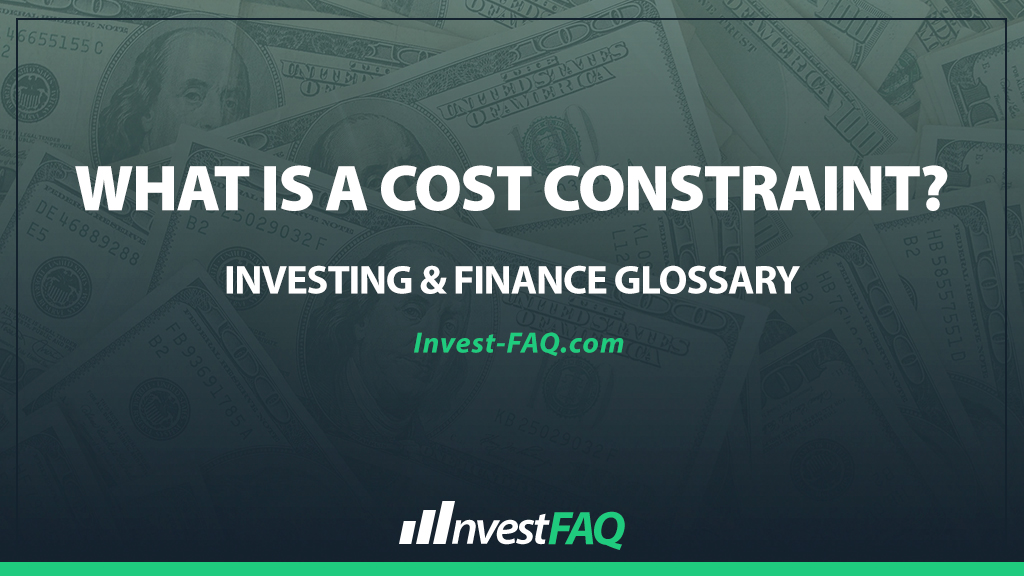
Cost Constraint
Contents
A cost constraint refers to the limitations companies face due to the finite resources available for conducting business operations, including budget restrictions, resource scarcity, or financial policies that cap spending. It is a critical factor in decision-making processes, influencing how businesses plan, execute, and prioritize projects and activities.
In business, recognizing and managing cost constraints is essential for strategic planning and operational efficiency. Organizations must often make trade-offs, deciding how best to allocate limited resources to meet their objectives.
This could involve prioritizing certain projects over others, optimizing resource use, or finding innovative solutions to reduce costs. Cost constraints drive companies to be more creative and efficient, ensuring they can achieve their goals within their financial means.
Example of a Cost Constraint
Imagine “Widget Manufacturing Ltd.,” which has set a budget of $100,000 for upgrading its machinery. However, the preferred machinery upgrade costs $120,000. Facing a cost constraint, the company must either negotiate the price down, choose a less expensive upgrade option, or reallocate funds from other areas of its budget. This scenario requires careful consideration of the company’s priorities and financial goals.
In this example, Widget Manufacturing Ltd.’s cost constraint requires the company to critically assess its options and make a decision that aligns with its strategic objectives without exceeding its budget.
Opting for a less expensive machinery upgrade or negotiating to lower the cost demonstrates strategic financial management, ensuring the company can improve its operations while adhering to its financial constraints. This decision-making process highlights the importance of flexibility and creativity in resource allocation and project management.
Types and Uses in Business Scenarios
Cost constraints are encountered in various business scenarios, including:
Project Management: Determining which projects to pursue or how to execute them within budget limitations.
Product Development: Deciding on features or materials based on cost considerations to meet budgetary goals.
Marketing Strategies: Crafting marketing campaigns that are effective yet cost-efficient.
Operational Decisions: Optimizing operations to reduce costs, such as finding more affordable suppliers or streamlining production processes.
These scenarios underscore the necessity for businesses to continually assess their strategies and operations against financial limitations to ensure sustainability and growth.
Significance for Investing & Finance
From an accounting perspective, the concept of a cost constraint is significant for several reasons:
Budgeting and Forecasting: It plays a crucial role in the development of realistic budgets and financial forecasts that account for the limitations of available resources.
Financial Reporting: Cost constraints can influence the valuation of assets, the recognition of expenses, and the determination of project feasibility, affecting financial statements and reports.
Resource Allocation: It informs the allocation of financial and non-financial resources, ensuring that investments and expenditures are aligned with the company’s financial capacity and strategic priorities.
In summary, a cost constraint represents the financial limitations within which a company operates, shaping its strategies, decisions, and operations.
Acknowledging and effectively managing these constraints is vital for businesses to optimize their resources, achieve their goals, and maintain financial health.
FAQ
How do cost constraints affect a company’s strategic planning process?
Cost constraints require companies to prioritize their strategic initiatives based on available financial resources, ensuring that plans are feasible within their budgetary limitations and align with long-term financial goals.
Can cost constraints lead to innovation within an organization?
Yes, cost constraints often encourage innovation by pushing teams to find more efficient, cost-effective solutions and creative ways to achieve their objectives without exceeding budgetary limits.
What role does cost management play in addressing cost constraints?
Cost management is critical in identifying and implementing strategies to optimize expenses and resource use, enabling a company to operate within its cost constraints while striving to meet its operational and financial objectives.
How should companies communicate cost constraint challenges to stakeholders?
Companies should transparently communicate cost constraint challenges to stakeholders through clear and regular updates, explaining how these limitations affect strategic decisions and what measures are being taken to address them, maintaining trust and alignment.
